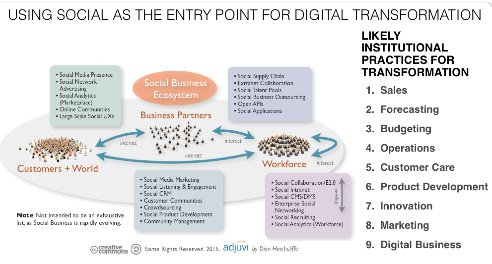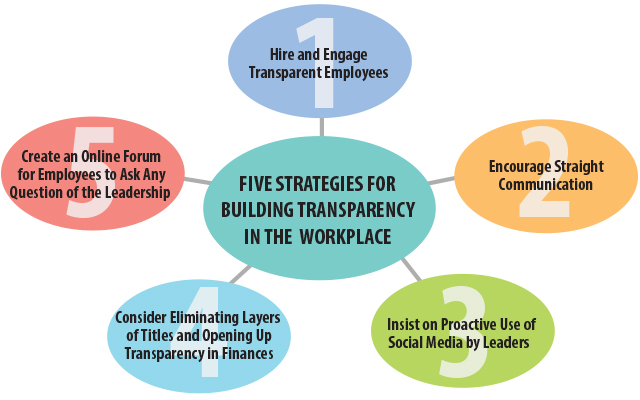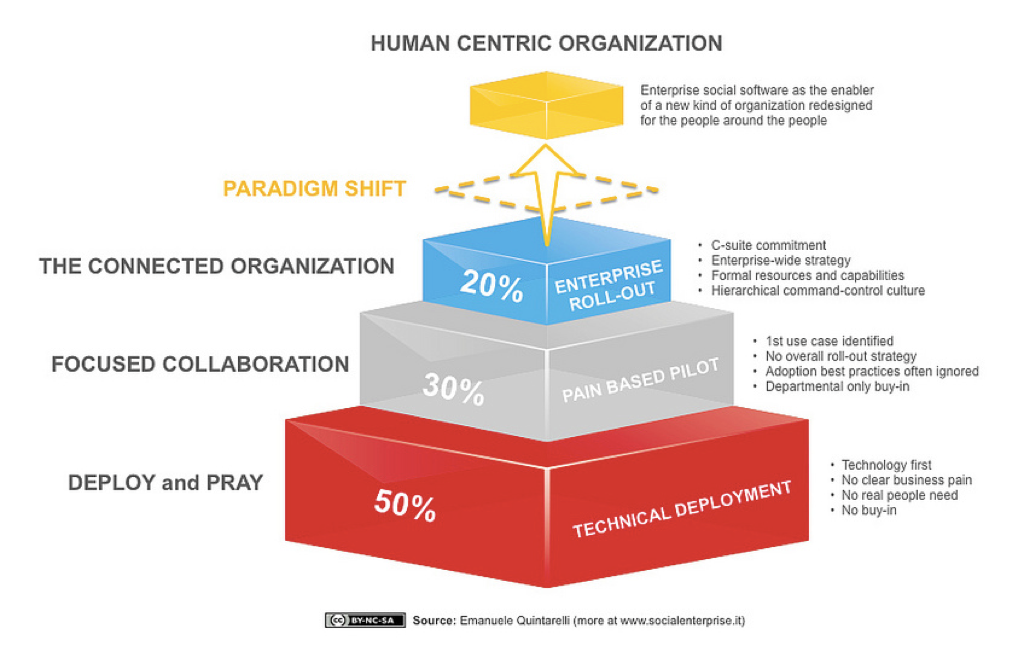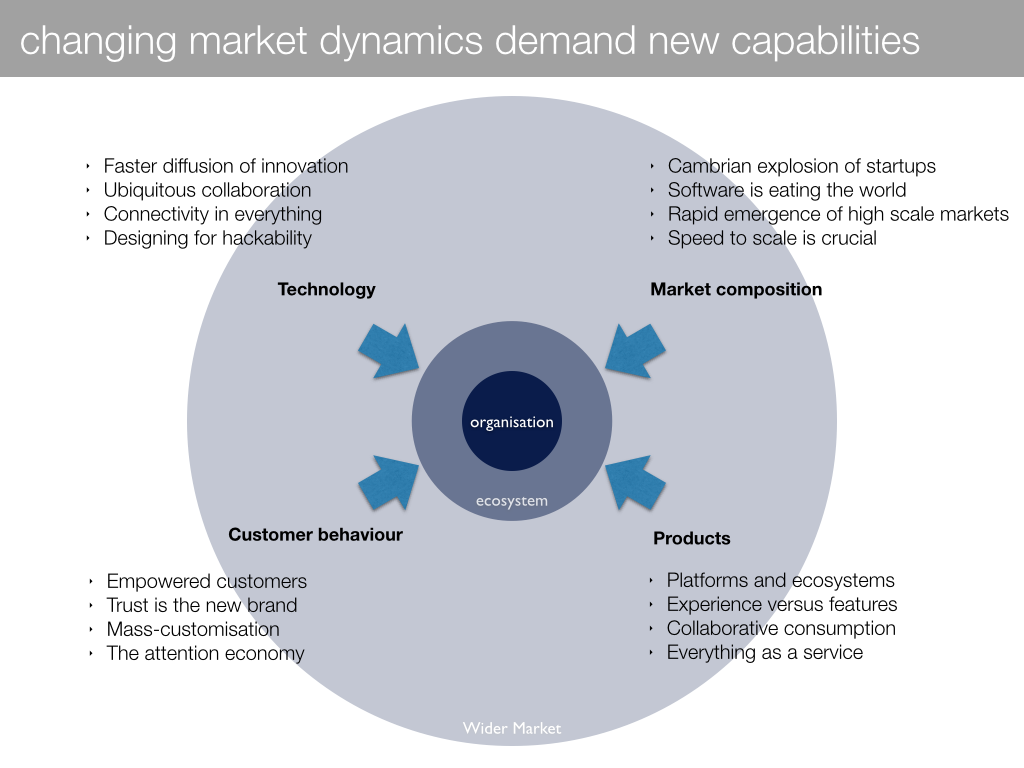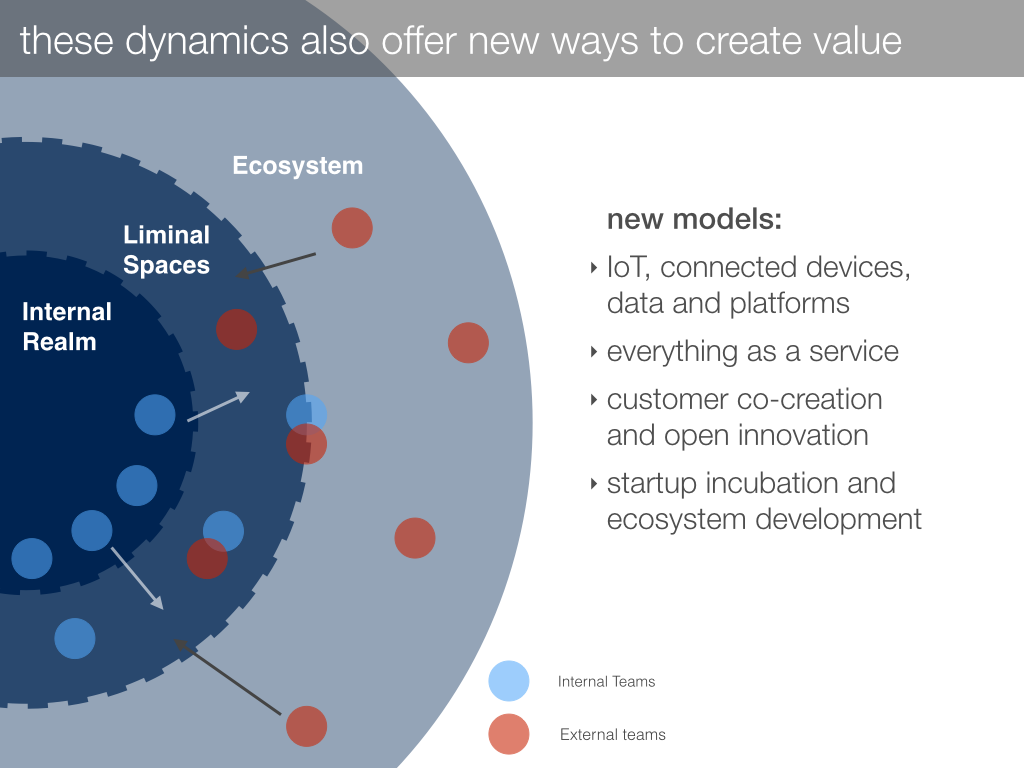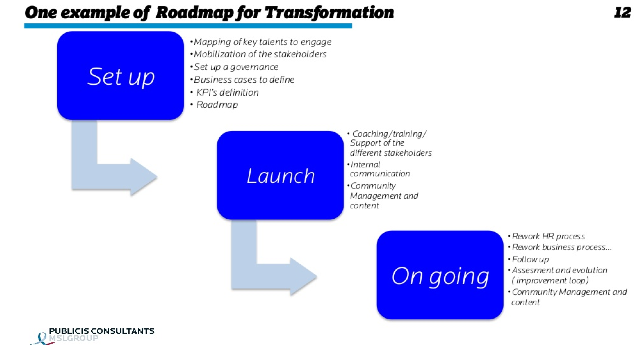-
Robert Reich: The sharing economy is hurtling us backwards
« The former secretary of labor outlines the increasingly dystopian future of America’s workforce «
-
The euphemism is the “share” economy. A more accurate term would be the “share-the-scraps” economy.
-
The big money goes to the corporations that own the software. The scraps go to the on-demand workers.
-
“People are monetizing their own downtime,” Arun Sundararajan, a professor at New York University’s business school, told the New York Times.
But this argument confuses “downtime” with the time people normally reserve for the rest of their lives.
-
But the biggest economic challenge we face isn’t using people more efficiently. It’s allocating work and the gains from work more decently.
-
-
Gartner : l’émergence des processus instables
« Pour trop d’entreprises, la révolution numérique ne représente guère plus que la transition d’une partie de leurs activités historiques vers des médias modernes, web ou mobile. Or, il s’agit de bien plus que cela. Par exemple, à l’approche de son prochain BPM Summit, le cabinet Gartner évoque la nécessaire transformation des processus. »
-
Dans cet environnement, la seule automatisation des processus existants – même si elle rend possible leur modification rapide – ne sera plus suffisante. Les organisations performantes seront celles qui sauront intégrer « nativement » l’instabilité au cœur de leurs modes opératoires.
-
L’entreprise devra être en mesure de se reconfigurer instantanément à l’apparition de nouveaux signaux (issus des gigantesques masses d’information produites sur le web, via l’internet des objets…).
-
Les processus réinventés seront adaptatifs et stimuleront la créativité, tout en devenant beaucoup plus résilients face aux évolutions de contexte
-
-
My digest of the Enterprise 2.0 Summit, Paris (February 2015)
« I’ve spent the last 1.5 days with Digital Workplace practitioners and thought leaders discussing the connected enterprise and social media inspired ways of working. Once again I have left the venue inspired and with a lot of food for thought. However, I have to admit that there is a struggle with the transition to the next phase. «
-
-
With the introduction of “social” to the mechanics of communication, collaboration & information flow within organizations we have changed the perspective from “outside” to “inside”. From a branding perspective we could – or actually should! – do the same thing when it comes to people brands.
-
If companies and their people managers are able to drive the profiling of high performers or subject matter wizards, we solve so many issues at the same time:
- Capturing of intellectual assets and exposure to the organisation
- Refinement and sharpening of people profiles as the foundation for relevance based delivery of information & communication
- Improved retrieval of expert profiles (automated or manually)
-
My strong belief is, that the fundamental business case (the organisational one) lies in the enablement of individuals and teams to successfully execute on core business processes and navigate through the company’s business logic.
-
What’s the project of your community?” I share her opinion that collaboration just for the collaboration’s sake doesn’t have much future in organisations that want to see some beef to the bone and ROI on their business productivity investments.
-
- Without executive buy-in enterprise 2.0 will be going nowhere.
- We need change agents and ambassadors to drive and implement change.
- Enterprise 2.0 isn’t a technology discussion. (Uhm…reality check: yes it is. In the end it always is. We just have to make sure that we have clarified the “why” and “what” before the CTO lets the “how” out of the box…pun intended).
- We need to nurture conversation and exchange across silos and we need to break up closed space thinking.
Transformation digitale, conseils inspirants de Google
« Web, data, digital ! une nouvelle façon d’entrer en relation avec ses clients ! Si on avait encore un doute dans la salle, Carlo d’Asaro Biondo, l’un des patrons charismatiques de Google a une nouvelle fois donné une leçon d’innovation-séduction… remplie de conseils très inspirants pour toute entreprise qui serait en pleine « e-réflexion ». «
-
1. Mettre le web au service des objectifs de l’entreprise, mais veiller avant tout à se concentrer sur les usages : partir des clients et de leur besoin.
-
2. N’utilisons pas le digital uniquement pour communiquer avec nos clients une fois qu’ils ont « acheté »,
-
3. Innovation digitale signifie « penser simple » ! Comme le moteur de recherche de Google dont Carlo nous rappelle les vertus : exhaustif, rapide, pertinent, ergonomique
-
4. Allons voir nos clients pour être sûr d’innover pour eux et arrêter de penser qu’il n’y a qu’un seul parcours client.
-
5. Mobilité ! c’est LE lien entre le « on line » et le « off line » : maintenant il y a un SEUL monde.
E2.0 Paris: A Summary in Case Studies
« I thought I would share my own summaries of the key case studies. They create a fantastic picture of the progress has made in E2.0 in Europe, but also demonstrate the journey ahead for even the most forward thinking, mature social businesses. »
-
SIKA: with over 17000 employees, SIKA has been working on it’s ESN for 3 years now. Based on IBM Connections, the platform came out of an initiative sparked by employees creating Linkedin groups for internal collaboration.
-
Michelin Group: Viewed as an innovation in both tools and ways of working, the ESN implementation at Michelin Group was based on the BlueKiwi platform. Describing the project, Michelin Group used a simple but effective model:
- Challenge – install new working practices to support faster growth for the group;
- Objectives – encourage innovation, empowerment, agility, deeper collaboration; and,
- Targeting – every employee, unit, entity and geography.
Comment Allianz se convertit aux réseaux sociaux
»
Comment Allianz fait sa révolution social media et transforme sa façon de travailler grâce à Twitter, Linkedin, Facebook et même Vine. »
-
Le discours a fait mouche et Twitter s’est imposé au fil des années comme un canal aussi important que le téléphone ou l’e-mail.
-
La transformation doit d’abord se faire en interne. Si les collaborateurs ne montent pas en compétence sur les réseaux sociaux nous ne pourrons pas répondre à certains de nos clients »
-
les employés les plus actifs sur le réseau social interne ne sont pas ceux de la communication et du marketing, mais du juridique ou de la finance, qui avaient besoin d’outils pour échanger et collaborer.
-
L’assureur veut maintenant passer à la vitesse supérieure, en transformant les réseaux sociaux en outils commerciaux, comme aide à la vente pour ses 1900 Agents Généraux (indépendants utilisant la marque Allianz), 2 560 conseillers (salariés d’Allianz) et son réseau de 1800 courtiers (qui distribuent les produits de plusieurs assureurs).
-
Pour accompagner les pionniers du « social selling », Allianz a mis en place un comité éditorial central qui définit les contenus intéressants à poster. Les utilisateurs de la plateforme peuvent ensuite puiser dans cette bibliothèque pour animer leurs pages Facebook et Linkedin.
-
C’est un projet à cheval entre le marketing et la distribution, avec un sponsorship très fort du comité exécutif »
-
« Les réseaux sociaux, ce n’est pas une question d’âge, mais d’état d’esprit.
Five Strategies for Building Transparency In The Workplace
« In the frenetic 21st century, when employees job-hop at an alarming pace, customers’ preferences change on a dime, and every week could bring a paradigm shift to the business world at large, what sets successful companies apart is one thing: loyalty. Loyal employees keep operations steady, prioritize long-term success, and preserve priceless institutional knowledge. »
-
-
- Hire and engage transparent employees
It all starts with your employees, so build into your talent acquisition process strategies to attract, engage and retain employees who display the attributes of transparency in everything they do
-
- Encourage straight communications
One of the most obvious vehicles toward an open and transparent workplace is clear communication.
-
- Insist on proactive use of social media by leaders
In a recent study, the public relations firm Weber Shandwick found that 76% of executives are in favor of CEOs using social media, in a survey of 630 senior professionals around the world.
La SNCF accélère sa transformation digitale en investissant 450 millions d’euros
» La SNCF finalement a connu 2 vagues et a décidé cette année, sous la coupe de Yves Tyrode qui a été nommé fin d’année dernière Chief Digital Officer de SNCF (après avoir mené à succès de nombreuses transformations chez Voyages-SNCF – voir la vidéo ITW que j’avais fait à l’époque), d’enclencher sa 3ème vague, celle de l‘accélération digitale. »
-
Le développement haut mobile dans les trains : vrai problème vécu par tous de la non accessibilité à la 3G, 4G (voire même Edge dans les trains). Globalement, rien de nouveau même si SNCF souhaite faire un pas fort vers les opérateurs pour aider ces derniers à déployer des antennes sur le réseau SNCF et ainsi augmenter l’accès à internet mobile dans les trains.
-
Simplifier la logique mobile de SNCF : jusqu’alors et comme de nombreuses maisons, le Digital se retrouvait éclaté entre de nombreuses branches sans tête pour coordonner.
-
Accélération de l’ouverture des données : SNCF s’est déjà engagée depuis plus de 3 ans dans une stratégie Open Data. SNCF veut accélérer en intégrant désormais un vrai business model derrière (à partir de fin mai).
-
La création d’un fonds d’investissements Digital SNCF Ventures doté de 30 millions d’euros.
-
la SNCF annonce le lancement de 4 Fabs appelés les 574 (qui correspond au record de vitesse en train battu par un SNCF) pour marquer là encore cette volonté d’aller vite.
The role of the Quantified Organisation in Digital Transformation
« My keynote there was about the idea of a Quantified Organisation as a method for managing and measuring Digital Transformation. The slides are embedded below, and an outline of the talk follows. »
-
In other words, when the existence of an enterprise social network and related apps is taken for granted, in much the same way as document storage and email servers, then we can start to think about what new behaviours, new structures and new practices they make possible.
-
But whilst most companies are tracking low-level KPIs regarding usage, adoption and in some cases even impact on existing business processes, there is a clear need for better ways of talking about the organisational impact of social technologies that is more specific than just describing the long-term characteristics we hope will result.
-
He argued that some kind of paradigm shift is needed to go beyond just adopting social technologies towards creating a new kind of organisation designed around people- and network-centric principles.
-
-
But organisational transformation tends to be driven by the question:
What is the purpose of our organisation and what capabilities does it need to meet the challenges of the future?
-
a capability-driven model identifies the properties needed by the organisation to be successful in the future even if it cannot predict exactly what is going to happen.
-
-
Digital transformation began with organisations trying to develop the external customer-facing social capabilities to operate in a world of empowered and connected consumers, but there is now a realisation that to deliver on this promise, the internal realm – how work is organised and how people connect to deliver value – is equally important
-
As Harald Schirmer from Continental put it during the summit, “we looked at what we have, what we need in the future and what we will need in 5 years” to drive social business efforts, not just immediate impact on the existing business.
-
-
Instead, digital transformation is more about gradual changes, loosely joined, that move towards the capabilities and ways of working we know we need to create.
-
Frederic Laloux, at his recent RSA talk, said that 50% of his answers to the question how to create self-managing organisations are to recommend ‘send and respond’ over ‘predict and control’ as a way of making change happen.
-
So if we can define some meaningful organisational health measures, and also ways of expressing our capability stories in testable and measurable ways, then we can do the same for the quantified organisation.
-
One goal of this approach to digital transformation is to create a kind of organisational self-awareness, sensing and responding to small problems or wrinkles that are getting in the way of people doing their job, which is why regular human input is so important.
-
If we can create the right organisational health measures, and if these are seen as meaningful indicators of transformation progress, then this model could greater strategic alignment to E2.0 and social business efforts.
-
Our approach starts with an analysis of existing pain points, external market dynamics and the needs of near-term business strategy to define a set of required organisational capabilities that can guide digital transformation and generate business value for existing social technology initiatives
-
We organise these into a pipeline categorised by ownership, impact, business domain (e.g. strategic level changes, major process level and small-scale use cases changes) and business priorities so that teams can dip in to select issues to tackle in sprints and mini-projects, and then re-prioritise based on outcomes.
-
Key to the success of this approach is a strong network of change agents, or what Kotter calls a ‘guiding coalition’ that is motivated to help transform the organisation at various levels. Executive support and protected spaces are also necessary for new practices to take root without being killed off by existing practices and politics.
-
- Understand how changing market dynamics impact the biz
- What organisational capabilities do these require?
- Express capabilities as ‘agile user stories’ for the org
- Define what success looks like and find relevant measures
- Give each manager, each team oversight of their structure
- Separate ‘what’ and ‘how’ in targets – let teams decide ‘how’
- Align E2.0 and change efforts to develop these capabilities
- Involve everyone in organisational self-awareness / change
- Develop your guiding coalition and align on purpose
- Do -> observe -> think; sense and respond; rinse and repeat
-
I think the model could also help companies move beyond their initial adoption plateau by providing a way to define new capabilities and new ways of working
La transformation digitale en baromètre
« CSC publie son Baromètre de la Transformation Digitale qui scrute les tendances et impacts en matière de transformation digitale des organisations. Pour 89% des répondants, le digital occupe une place primordiale au sein de leur organisation »
-
Rupture numérique dans 2 ans : mythe ou réalité ?
Une des conséquences de cette mutation numérique réside notamment dans l’apparition de nouveaux « business models » dits « disruptifs », c’est-à-dire en rupture avec les modèles traditionnels. Pour 57% des répondants, cette rupture numérique est déjà présente, et pour 29%, elle le sera dans les 2 prochaines années.
-
Conscience des risques
Malgré les opportunités offertes par le développement du digital, 52% des répondants perçoivent cette transition comme une menace importante (voire très importante) pour leur organisation. L’émergence de technologies de rupture, l’apparition de modèles économiques disruptifs, l’évolution des comportements clients (plus tribaux, moins classiques et plus claniques), la nécessité de développer une acculturation des collaborateurs au digital ont clairement complexifié l’écosystème des organisations. Avec
-
Impact du digital sur les organisations
Les effets de la digitalisation sur les organisations sont multiples. Et la manière de l’aborder se focalise sur 3 composantes clés du changement : pour 93% des répondants, le digital implique une réinvention de la relation client (par le biais notamment d’un mode de communication entreprise – client plus direct et individualisé) ; pour 82%, le digital doit contribuer à faire évoluer les modes de management (travail à distance, travail collaboratif, rupture des silos organisationnels et hiérarchiques historiques, développement de la transversalité notamment via les réseaux sociaux d’entreprise…) ; enfin, pour 81%, le digital doit également participer à l’amélioration de l’efficacité opérationnelle via la transformation des processus opérationnels et de support (dématérialisation de certains services, développement du self-care et de l’intégration de partenaires dans l’écosystème, socialisation des processus via des workflows intégrés…).
-
Le digital et les offres
Alors que le digital favorise une relation client/entreprise davantage directe et bilatérale, l’implication en amont des clients dans la conception d’offres et de services reste encore au stade expérimental
-
On s’informe comment?
En 2014, pour une très grande majorité des répondants (76%), le digital modifie largement la manière dont les clients s’informent sur les offres. Plus encore qu’en matière de cycle de conception – développement, l’accès aux offres est impacté par les évolutions digitales. La multiplicité des canaux (médias sociaux, blogs spécialisés, site de l’entreprise) offre aux clients davantage d’accès à l’information et ce, à tout moment et de manière quasi instantanée.
-
Le digital et l’après-vente
Les canaux numériques ont fortement impacté le cycle d’après-vente de la relation client (SAV, réclamations…) pour près de 70% de nos répondants
-
De nouveau business model
Près de la moitié des interrogés privilégient une évolution de modèle axé sur le développement de nouveaux services (extension de gammes de services commercialisés, diversification et développement de nouveaux produits et services digitaux) : moins impactant sur leur modèle opérationnel, ces évolutions permettent notamment de créer de la valeur ajoutée sur des domaines hors du « core business » de l’organisation (en adjoignant des services potentiellement sourcés hors du périmètre naturel de l’entreprise, celle-ci peut progressivement créer de la fidélité et de l’attachement à moindre frais, mais sous réserve que le « delivery » de ces services soit réalisé de manière efficace) ;
-
Le digital et l’évolution des usages
En 2014, 2/3 des répondants estiment que le client a le choix du canal de contact lors de son parcours d’achat. Cette réalité reste pourtant à nuancer puisque moins de la moitié des répondants issus du secteur des services semble encore laisser ce choix au client.
-
Cross-canalité et parcours client
Là encore, près de 2/3 des répondants évaluent le degré de cross-canalité comme insuffisant.
-
Degré de dématérialisation des processus
Une majorité de répondants (45%) déclarent que seuls quelques processus-clés sont dématérialisés au sein de leur organisation. La dématérialisation, qui peut consister à numériser un processus aujourd’hui au moins partiellement supporté par des échanges papiers, est pourtant un des enjeux clés de la transformation digitale
-
Entreprise : où en est la culture digitale ?
Développer une culture digitale auprès des collaborateurs et faire évoluer les modes de management grâce aux technologies digitales. Un enjeu clé pour nombre d’organisations qui voient cohabiter en leur sein des populations hétérogènes, issues des générations du baby-boom, X, Y, Z… Au-delà d’acculturer les collaborateurs aux évolutions digitales (à la fois pour mieux leur faire appréhender les attentes de leurs clients B2C et B2B, mais également leur faire prendre conscience des opportunités et ruptures induites par le digital),
Une nouvelle profession en phase d’expansion : le Customer Journey Officer
« Désormais, l’avenir du marketing tient au processus de cartographie et d’implémentation des parcours clients. Avec autant d’enjeux, un directeur de parcours clients doit veiller au bon déroulé de ces parcours individuels. »
-
Tout d’abord, et surtout : connaissez-vous vos clients ?
Les clients s’attendent à ce que vous compreniez ce qu’ils sont, et ce que vous vous connectiez avec eux à un niveau très personnel
-
Seconde question : savez-vous où ils se trouvent dans leur parcours ?
Il n’est pas suffisant de connaître vos clients. Vous devez savoir où ils se situent dans leur parcours avec votre entreprise. Sont-ils des clients déjà existants ou anciens ? Ont-ils téléchargé votre application ?
-
Troisième question : avez-vous une stratégie pour déplacer les clients le long du parcours ?
Une fois que vous avez les deux premières réponses, il faut se concentrer sur un plan de cartographie des parcours clients hautement personnalisés
-
Enfin, la dernière question et non des moindres : êtes-vous capable d’en mesurer l’impact financier ?
La manière de mesurer l’impact financier devrait être directement liée au parcours client. Vous devriez être capable de voir à chaque moment donné où un client se situe dans son parcours.
Enterprise 2.0 summit : Roadmap of organizational development for dig…

